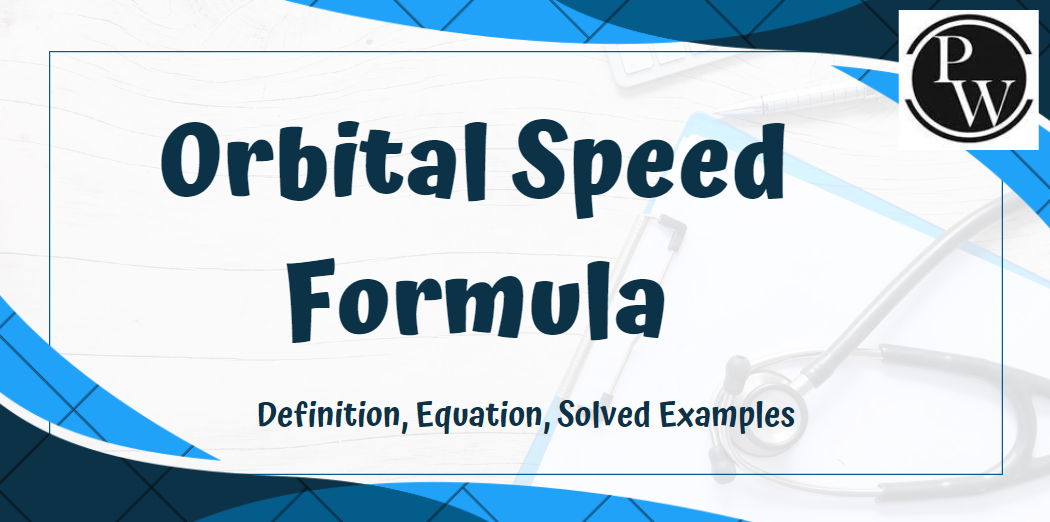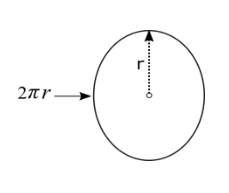

Definition Of Orbital Speed Formula
Orbital Speed Formula: Orbital speed, in simple terms, is the velocity at which an object needs to travel to stay in a stable orbit around another celestial body. It is a delicate balance between the gravitational force pulling the object towards the central body and its tangential velocity. Units Orbital speed can be expressed in various units, but the most common ones are meters per second (m/s) and kilometers per hour (km/h).
Orbital Speed Formula
Orbital Speed Formula: The orbital speed formula is used to calculate the velocity required for an object to stay in a stable orbit around another celestial body, such as a planet, moon, or star. The formula is as follows: V = √(GM/R) Here's what each component of the formula represents:- V (Orbital Speed): This is the velocity, or speed, at which the object must travel to maintain a stable orbit. It's usually measured in units like meters per second (m/s) or kilometers per hour (km/h), depending on the context.
- G (Universal Gravitational Constant): This is a fundamental physical constant that signifies the strength of the gravitational force between two objects. The value of G is constant and is used in various gravitational calculations.
- M (Mass of the Central Body): This refers to the mass of the celestial body around which the object is orbiting. For Earth, the mass of M is approximately 5.972 × 10^24 kilograms. For other celestial bodies, you would use their respective mass values.
- R (Distance from the Center of the Central Body): R represents the distance between the center of the central body and the orbiting object. It is crucial in determining the orbital speed.
Solved Questions Of Orbital Speed Formula
- Calculate the orbital speed of a satellite orbiting Earth at an altitude of 300 kilometers.
- What is the orbital speed of the International Space Station (ISS) orbiting at an altitude of approximately 420 kilometers?
- If we increase the altitude of a satellite in orbit, will its orbital speed increase or decrease? Explain.
- Calculate the orbital speed required for a satellite to orbit Mars (mass of Mars ≈ 6.417 × 10^23 kg) at an altitude of 400 kilometers above its surface.
- What happens to the orbital speed if the mass of the central body (e.g., Earth) increases while keeping the altitude constant?
- Find the orbital speed of a hypothetical moon with a mass of 1.2 × 10^22 kg orbiting a gas giant planet with a mass of 1.9 × 10^27 kg at a distance of 1.5 million kilometers.
- Why is it more fuel-efficient for spacecraft to perform a gravitational slingshot maneuver using a planet's gravity to increase their speed instead of using their engines?
- How does the orbital speed of a geostationary satellite (orbiting at an altitude of approximately 36,000 kilometers) compare to that of a satellite in low Earth orbit?
- Explain the concept of escape velocity and its relationship to orbital speed.
- Can a satellite remain in orbit indefinitely, or does it require periodic adjustments to its speed? Explain.
Orbital Speed Formula FAQs
What is orbital speed, and why is it important?
Orbital speed is the velocity required for an object to stay in a stable orbit around another celestial body. It's important because it enables satellites and space objects to remain in space without falling back to Earth.
How is orbital speed calculated?
Orbital speed is calculated using the formula: V = sqrt(GM / R), where G is the universal gravitational constant, M is the mass of the central body, and R is the distance from the center of the central body to the orbiting object.
Does increasing the altitude of a satellite increase its orbital speed?
No, increasing the altitude of a satellite decreases its orbital speed. A higher altitude means a greater distance from the central body, which requires a lower orbital speed to maintain a stable orbit.
How does the mass of the central body affect orbital speed?
The mass of the central body directly affects orbital speed. A higher mass central body requires a higher orbital speed for an object to remain in orbit around it.
🔥 Trending Blogs
Talk to a counsellorHave doubts? Our support team will be happy to assist you!

Check out these Related Articles
Free Learning Resources
PW Books
Notes (Class 10-12)
PW Study Materials
Notes (Class 6-9)
Ncert Solutions
Govt Exams
Class 6th to 12th Online Courses
Govt Job Exams Courses
UPSC Coaching
Defence Exam Coaching
Gate Exam Coaching
Other Exams
Know about Physics Wallah
Physics Wallah is an Indian edtech platform that provides accessible & comprehensive learning experiences to students from Class 6th to postgraduate level. We also provide extensive NCERT solutions, sample paper, NEET, JEE Mains, BITSAT previous year papers & more such resources to students. Physics Wallah also caters to over 3.5 million registered students and over 78 lakh+ Youtube subscribers with 4.8 rating on its app.
We Stand Out because
We provide students with intensive courses with India’s qualified & experienced faculties & mentors. PW strives to make the learning experience comprehensive and accessible for students of all sections of society. We believe in empowering every single student who couldn't dream of a good career in engineering and medical field earlier.
Our Key Focus Areas
Physics Wallah's main focus is to make the learning experience as economical as possible for all students. With our affordable courses like Lakshya, Udaan and Arjuna and many others, we have been able to provide a platform for lakhs of aspirants. From providing Chemistry, Maths, Physics formula to giving e-books of eminent authors like RD Sharma, RS Aggarwal and Lakhmir Singh, PW focuses on every single student's need for preparation.
What Makes Us Different
Physics Wallah strives to develop a comprehensive pedagogical structure for students, where they get a state-of-the-art learning experience with study material and resources. Apart from catering students preparing for JEE Mains and NEET, PW also provides study material for each state board like Uttar Pradesh, Bihar, and others
Copyright © 2025 Physicswallah Limited All rights reserved.
Get App











